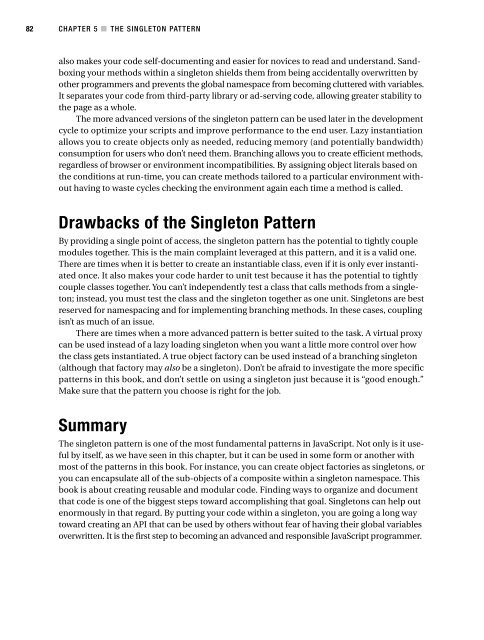Design Patterns
Download - Assembla
Download - Assembla
- No tags were found...
You also want an ePaper? Increase the reach of your titles
YUMPU automatically turns print PDFs into web optimized ePapers that Google loves.
82<br />
CHAPTER 5 ■ THE SINGLETON PATTERN<br />
also makes your code self-documenting and easier for novices to read and understand. Sandboxing<br />
your methods within a singleton shields them from being accidentally overwritten by<br />
other programmers and prevents the global namespace from becoming cluttered with variables.<br />
It separates your code from third-party library or ad-serving code, allowing greater stability to<br />
the page as a whole.<br />
The more advanced versions of the singleton pattern can be used later in the development<br />
cycle to optimize your scripts and improve performance to the end user. Lazy instantiation<br />
allows you to create objects only as needed, reducing memory (and potentially bandwidth)<br />
consumption for users who don’t need them. Branching allows you to create efficient methods,<br />
regardless of browser or environment incompatibilities. By assigning object literals based on<br />
the conditions at run-time, you can create methods tailored to a particular environment without<br />
having to waste cycles checking the environment again each time a method is called.<br />
Drawbacks of the Singleton Pattern<br />
By providing a single point of access, the singleton pattern has the potential to tightly couple<br />
modules together. This is the main complaint leveraged at this pattern, and it is a valid one.<br />
There are times when it is better to create an instantiable class, even if it is only ever instantiated<br />
once. It also makes your code harder to unit test because it has the potential to tightly<br />
couple classes together. You can’t independently test a class that calls methods from a singleton;<br />
instead, you must test the class and the singleton together as one unit. Singletons are best<br />
reserved for namespacing and for implementing branching methods. In these cases, coupling<br />
isn’t as much of an issue.<br />
There are times when a more advanced pattern is better suited to the task. A virtual proxy<br />
can be used instead of a lazy loading singleton when you want a little more control over how<br />
the class gets instantiated. A true object factory can be used instead of a branching singleton<br />
(although that factory may also be a singleton). Don’t be afraid to investigate the more specific<br />
patterns in this book, and don’t settle on using a singleton just because it is “good enough.”<br />
Make sure that the pattern you choose is right for the job.<br />
Summary<br />
The singleton pattern is one of the most fundamental patterns in JavaScript. Not only is it useful<br />
by itself, as we have seen in this chapter, but it can be used in some form or another with<br />
most of the patterns in this book. For instance, you can create object factories as singletons, or<br />
you can encapsulate all of the sub-objects of a composite within a singleton namespace. This<br />
book is about creating reusable and modular code. Finding ways to organize and document<br />
that code is one of the biggest steps toward accomplishing that goal. Singletons can help out<br />
enormously in that regard. By putting your code within a singleton, you are going a long way<br />
toward creating an API that can be used by others without fear of having their global variables<br />
overwritten. It is the first step to becoming an advanced and responsible JavaScript programmer.











